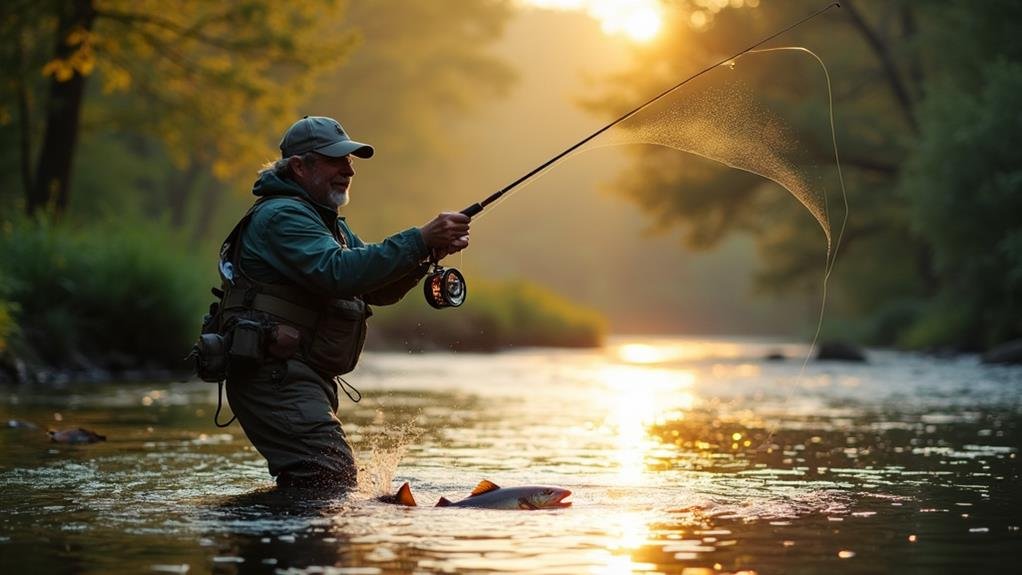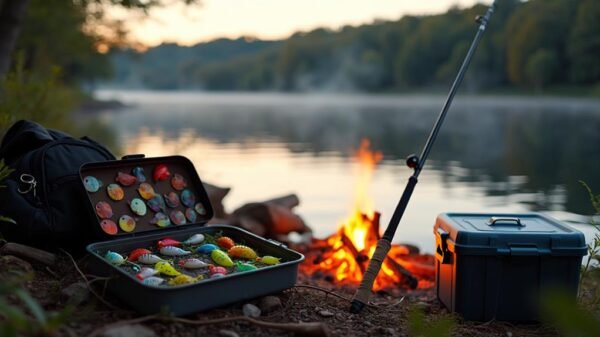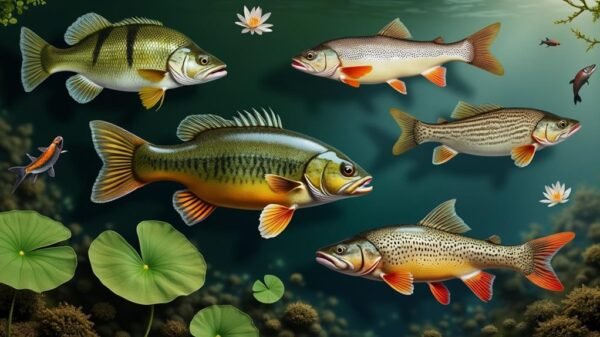To up your trout fishing game, start by grasping their habits and habitats. Trout are most active in the early morning and late evening, and they prefer cooler waters around 50-65°F. Pay attention to water conditions; clear streams require stealth while murky waters let you use brighter lures. Choose the right bait—live bait like nightcrawlers or vibrant artificial lures work wonders. Master your casting technique by keeping a firm grip and experimenting with angles. Don't forget to adjust your approach with the seasons, as trout behavior changes throughout the year. Keep going, and you'll unearth even more tips!
Understanding Trout Behavior
Trout are intriguing fish, and grasping their behavior can significantly boost your fishing outcomes. These aquatic animals react sensitively to their environment, making awareness of their patterns crucial. They frequently conceal themselves under stones, among plants, or close to structures, patiently waiting for food. By understanding their preferred habitats, you can heighten your chances of a successful catch.
Furthermore, elements like optimal fishing times can greatly influence your approach. Trout exhibit heightened activity during early morning and late evening. Throughout the day, they often retreat to cooler, deeper waters, particularly during warmer months. Monitoring water temperature is important; trout thrive in temperatures around 50-65°F.
Additionally, be mindful of their feeding habits. Trout primarily consume insects, smaller fish, and crustaceans, so aligning your bait with their diet is vital. For example, employing a fly that mimics mayflies can be particularly effective during hatch seasons.
Lastly, consider how weather conditions can affect trout behavior. Overcast days often encourage trout to be more active. The more you learn about these patterns, the better equipped you'll be to land that ideal catch. Embrace this knowledge, and enjoy the thrill of successful fishing.
Assessing Water Conditions

Water conditions significantly impact successful trout fishing. When you arrive at the stream, take a moment to evaluate it. Observe the transparency, temperature, and current. Clear streams often require stealthy approaches. Trout, being sensitive creatures, can easily be spooked, so move quietly and avoid casting shadows on the water. In contrast, murky waters can provide a sense of safety for trout, allowing you to use bright or noisy lures, like those from Rapala, to draw their attention.
Next, monitor the water temperature. Trout flourish in cooler environments, typically ranging from 50°F to 65°F. If the stream feels warm, consider fishing during the cooler parts of the day, such as early mornings or late evenings. Lastly, assess the water current. Rapid flows can push trout into calmer areas, like eddies or behind rocks. Concentrate your efforts in these spots, as they often harbor fish.
Choosing the Right Bait

Choosing the ideal bait can significantly impact your trout fishing success. It's essential to align your bait with the trout's natural diet, considering what they're consuming in your chosen fishing location. Live bait, such as nightcrawlers or small minnows, tends to be highly effective, as trout are attracted to fresh food sources. If you're up for a challenge, consider using artificial lures like TRUSCEND Lifelike Fishing Lures, which imitate the movement and coloration of trout's natural prey.
When selecting lures, opt for spinners or spoons in vibrant colors, particularly on overcast days. These can easily capture a trout's attention and trigger a strike. Conversely, on sunny days, choose more subdued shades that blend with the environment. Additionally, experimenting with various sizes can yield results; sometimes a smaller lure may entice a selective trout.
Power baits, like Berkley PowerBait, can also be transformative. These doughy baits come in a range of colors and scents, effectively attracting fish from afar. Remember, adaptability is key. If one type of bait fails to produce results, don't hesitate to switch gears! Embrace the journey, and you'll soon discover the perfect bait to reel in those trout.
Mastering Casting Techniques

When you're out angling, refining your casting skills can significantly impact your success. The first step is to establish your grip. Hold the fishing rod comfortably with your dominant hand while using your opposite hand to steady the reel. This equilibrium provides control over your throw. Knowing the best times to catch trout, such as during dawn and dusk, can enhance your chances.
Next, concentrate on your posture. Stand with your feet hip-width apart, slightly bending your knees. This firm foundation aids in transferring your body's energy into the cast. As you prepare to throw, keep your elbow close to your torso.
When you're set, lift the rod behind you, then swiftly propel it forward in a fluid motion. Timing is crucial—allow the fishing line to extend as you complete the motion. Consistent practice is vital; experiment with various angles and distances to discover what suits you best.
Remember to maintain flexibility in your wrist; this adds finesse to your throw. If you're angling in confined areas, a sidearm throw might be most effective. With these strategies, you'll gain confidence and freedom on the water, enabling you to target those elusive trout with precision and expertise. Happy angling!
Utilizing Seasonal Patterns

As the seasons transition, trout behavior alters, necessitating adjustments in your fishing tactics. In spring, with rising water temperatures, trout exhibit increased activity and move into shallower regions. This heightened movement is often driven by factors such as water temperature and insect hatches, so opt for lighter gear and concentrate on emerging insects; nymphs from brands like Orvis can be particularly effective.
During summer, as temperatures rise, trout typically retreat to deeper, cooler waters. The early morning and late evening hours provide the best chances for success. Seek out shaded spots and consider using dry flies from companies like Simms or small spinners to attract them.
As fall approaches, trout intensify feeding to prepare for the winter months. This period invites exploration of various depths and the use of larger lures. Experimenting with different colors, such as vibrant oranges and yellows, can lead to notable results.
Winter fishing presents its challenges, yet can be rewarding. Trout tend to slow down, making the use of smaller baits and fishing near the bottom effective strategies. Brands like Rapala offer excellent options for winter lures that can enhance your success.























